Related Research Articles

Israeli settlements, also called Israeli colonies, are the civilian communities built by Israel throughout the Israeli-occupied territories. They are populated by Israeli citizens, almost exclusively of Jewish identity or ethnicity, and were first established after Israel's victory in the Six-Day War of June 1967. The international community considers Israeli settlements to be illegal under international law, but Israel disputes this. The expansion of settlements often involves the confiscation of Palestinian land and resources, leading to displacement of Palestinian communities and creating a source of tension and conflict. Settlements are often protected by the Israeli military and are frequently flashpoints for violence against Palestinians. Further, the presence of settlements and Jewish-only bypass roads creates a fragmented Palestinian territory, seriously hindering economic development and freedom of movement for Palestinians.
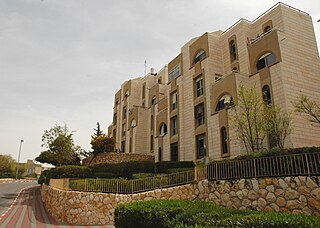
Ma'ale Adumim is an urban Israeli settlement organized as a city council in the West Bank, seven kilometers east of Jerusalem. Ma'ale Adumim achieved city status in 1991. In 2015, its population was 37,555. It is located along Highway 1, which connects it to Jerusalem and the Tel Aviv Metropolitan Area. The international community considers Israeli settlements in the West Bank illegal under international law, but the Israeli government disputes this.

The Geneva Initiative, also known as the Geneva Accord, is a draft Permanent Status Agreement to end the Israeli–Palestinian conflict, based on previous official negotiations, international resolutions, the Quartet Roadmap, the Clinton Parameters, and the Arab Peace Initiative. The document was finished on 12 October 2003.

Gush Etzion is a cluster of Israeli settlements located in the Judaean Mountains, directly south of Jerusalem and Bethlehem in the West Bank. The core group includes four Jewish agricultural villages that were founded in 1943–1947, and destroyed by the Arab Legion before the outbreak of the 1948 Arab–Israeli War, in the Kfar Etzion massacre. The area was left outside of Israel with the 1949 armistice lines. These settlements were rebuilt after the 1967 Six-Day War, along with new communities that have expanded the area of the Etzion Bloc. As of 2011, Gush Etzion consisted of 22 settlements with a population of 70,000.

Efrat, or previously officially Efrata, is an Israeli settlement in the West Bank, established in 1983 in the Judean Mountains. Efrat is located 12 kilometers (7.5 mi) south of Jerusalem, between Bethlehem and Hebron, 6.5 km (4 mi) east of the Green Line, at the Palestinian side of the West Bank wall. The settlement stands at an altitude of up to 960 metres above sea level and covers about 6,000 dunam. The international community considers Israeli settlements in the West Bank illegal under international law, but the Israeli government disputes this.

Giv'at Ze'ev is an urban Israeli settlement in the West Bank, five kilometers northwest of Jerusalem. The settlement was founded in 1977 on the site of the abandoned Jordanian military camp, adjacent to the site of ancient Gibeon. While it lies within the borders of the Matte Binyamin Regional Council, it is a separate municipal entity. In 2021 it had a population of 20,034.
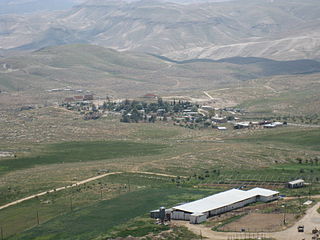
Ma'ale Rehav'am is an Israeli outpost in the West Bank, located south of Bethlehem and northeast of Hebron in the northeastern Judean Mountains on Road 3698 in the eastern Etzion bloc. Its mother community, the settlement of Nokdim is administrated by the Gush Etzion Regional Council, which lists Ma'ale Rehav'am as a separate "community" on its official website.

Gevaot is an Israeli outpost located in the West Bank, in the westernmost area of the Gush Etzion settlement bloc. It is named for the hills from which Balaam spoke, according to Numbers 23:9, just like the neighbouring settlement Rosh Tzurim.

Elazar is an Israeli settlement in the West Bank, 18 kilometers south of Jerusalem in the Gush Etzion cluster of settlements. A community settlement, it had a population of 2,561 in 2021. It is administered by the Gush Etzion Regional Council. The international community considers Israeli settlements in the West Bank illegal under international law, although the Israeli government disputes this.

Kedar is a rural Israeli settlement in the West Bank. Located to the south of Ma'ale Adumim and organised as a community settlement, it falls under the jurisdiction of Gush Etzion Regional Council. In 2021 it had a population of 1,617.
Migdal Oz is an Israeli settlement and income-sharing community kibbutz in the West Bank. Located in the historic Etzion bloc 7.4 km from the Green Line and west of the Israeli West Bank barrier, it falls under the jurisdiction of Gush Etzion Regional Council. It neighbors the communities of Kfar Etzion, Alon Shevut, Elazar and Efrat. In 2021 it had a population of 567.
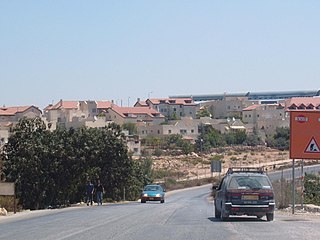
Alon Shvut is an Israeli settlement in the West Bank, established in June 1970 over lands confiscated from the nearby Palestinian town of Khirbet Beit Zakariyyah. It is part of the Etzion bloc of the West Bank, administered by the Gush Etzion Regional Council, and neighbors the Israeli settlements of Kfar Etzion, Rosh Tzurim, Neve Daniel, Elazar, Bat Ayin, Migdal Oz, and Efrat. In 2021, its population was 3,061.
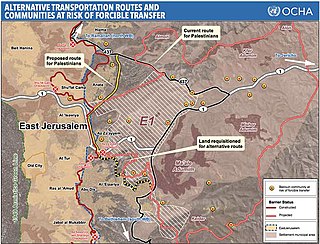
E1 – also called the E1 area, E1 zone or E1 corridor – is an area of the West Bank within the municipal boundary of the Israeli settlement of Ma'ale Adumim. It is located adjacent to and northeast of East Jerusalem and to the west of Ma'ale Adumim. It covers an area of 12 square kilometres (4.6 sq mi), which is home to a number of Bedouin communities including the village of Khan al-Ahmar and their livestock as well as a large Israeli police headquarters. The Palestinian tent site of Bab al Shams, which was established for several days in early 2013, also lay within this area.

This is a timeline of the development of and controversy over Israeli settlements. As of January 30, 2022 the West Bank settlement population was 490,493 and the settler population in the Golan Heights was almost 27,000 and in East Jerusalem the settler population was around 220,000.

Gush Etzion Junction("Tzomet HaGush") also known as Gush Junction is a 120-dunam business, commercial and tourism center in the southern West Bank, which serves as the entry point to the Gush Etzion bloc of settlements. It is administered by the Gush Etzion Regional Council.
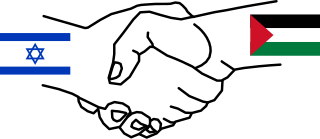
The Palestine Papers is a collection of confidential documents about the Israeli–Palestinian peace process leaked to Al Jazeera, which published them between 23 and 26 January 2011. Nearly 1,700 documents from the office of the main PLO negotiator, Saeb Erekat, and his team have been published, dating from 1999 to 2010.
Amana ('Covenant') is an Israeli settlement movement formed by Gush Emunim in 1976. Its primary goal was "developing communities in Judea, Samaria, the Golan Heights, the Galilee, the Negev and Gush Katif." The initial communities it developed were Ofra, Mevo Modi'in, Kedumim, and Ma'aleh Adumim. Settlements developed in the West Bank, including East Jerusalem, are illegal under international law.
Ari Fuld, an American-Israeli who lived in the Israeli settlement of Efrat, was stabbed to death by a Palestinian at the Gush Etzion Junction in the West Bank on 16 September 2018.
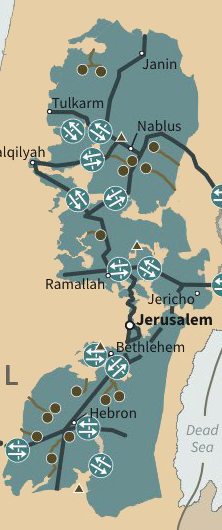
The Palestinian enclaves are areas in the West Bank designated for Palestinians under a variety of unsuccessful U.S. and Israeli-led proposals to end the Israeli–Palestinian conflict. The enclaves are often compared to the nominally self-governing black homelands created in apartheid-era South Africa, and are thus referred to as bantustans. They have been referred to figuratively as the Palestinian archipelago, among other terms. The de facto status in 2024 is that Israel controls all area outside these enclaves.
References
- ↑ Martin Blecher (15 October 2018). Israeli Settlements: Land Politics beyond the Geneva Convention. Rowman & Littlefield. pp. 132–. ISBN 978-0-7618-7065-4.
- ↑ Report on Israeli Settlement in the Occupied Territories, https://fmep.org/wp/wp-content/uploads/2015/01/11.2.pdf 2001 p=4
- ↑ "Netanyahu and the Settlements". New York Times. March 12, 2015. Retrieved December 3, 2019.
- 1 2 3 Pressman, Jeremy (2003). "Visions in Collision: What Happened at Camp David and Taba?". International Security. 28 (2): 20. doi:10.1162/016228803322761955. JSTOR 4137467. S2CID 57564925.
- ↑ "Explained: How big an obstacle are Israeli settlements to peace?". Haaretz. February 14, 2017. Retrieved December 9, 2019.
- ↑ http://www.ajtransparency.com/files/4736.pdf [ bare URL PDF ]
- ↑ Alan Dowty (22 February 2019). The Israel/Palestine Reader. Wiley. pp. 185–. ISBN 978-1-5095-2737-3.
- ↑ "Netanyahu Proposes Talks on Borders of Settlement Blocs". Haaretz. May 26, 2015. Retrieved December 9, 2019.
- ↑ "How Many Settlers Really Live in the West Bank? Haaretz Investigation Reveals". Haaretz. June 15, 2017. Retrieved December 13, 2019.
- ↑ "Israel's Greater Jerusalem Bill". Jurist. March 5, 2018. Retrieved December 9, 2019.
- ↑ "Netanyahu insists Jordan Valley annexation discussed with Pompeo". Jerusalem Post. December 8, 2019. Retrieved December 8, 2019.